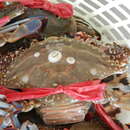Diagnostic Description
(
Inglês
)
fornecido por FAO species catalogs
Carapace rough to granulose with regions discernible. Front with 3 acutely triangular teeth with the central projected slightly forwards of the lateral ones; 9 teeeth on each anterolateral margin, the most external one much larger than the preceding. Chelipeds elongate: larger chelae with conical tooth at the base of fingers; 4 spines on the inner margin of the merus. Legs laterally flattened to variyng degrees, last 2 segments of last pair paddle-like. Carapace colour dull green to brown.
Sakai, T.1976 Crabs of Japan and the adjacent seas. Kodansha Ltd. Tokyo. 773 p.
Distribution
(
Inglês
)
fornecido por FAO species catalogs
Indic and West Pacific Oceans: Southeast and East Asia (from Japan, Korea, China and Formosa and the Bay of Bengala), to the West, North and East of Australia.
Size
(
Inglês
)
fornecido por FAO species catalogs
Maximum carapace width 15 cm (males). A male of 149 mm cw has a carapace lenght of 70 mm.
Brief Summary
(
Inglês
)
fornecido por FAO species catalogs
Habiting sandy and sand-muddydepths in shallow waters to 50 m depth.
Benefits
(
Inglês
)
fornecido por FAO species catalogs
Caugth mainly by trawling. It is an important commercial species in Japan, where it is a common edible crab, and it is collected in large numbers in some areas. The total catch reported for this species to FAO for 1999 was 284 851 t. The countries with the largest catches were China (270 280 t) and Korea, Republic of (11 819 t).

